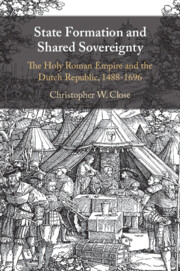Book contents
- State Formation and Shared Sovereignty
- State Formation and Shared Sovereignty
- Copyright page
- Contents
- Maps
- Acknowledgments
- Abbreviations
- Maps
- Introduction
- 1 The Swabian League and the Politics of Alliance (1488–1534)
- 2 Alliances and the Early Reformation (1526–1545)
- 3 Alliances and New Visions for the Empire and the Low Countries (1540–1556)
- 4 Shared Sovereignty and Regional Peace (1552–1567)
- 5 Shared Sovereignty and Multi-confessionality in the Empire and the Low Countries (1566–1609)
- 6 Religious Alliance and the Legacy of Past Leagues (1591–1613)
- 7 Religious Alliance and the Thirty Years’ War (1610–1632)
- 8 Westphalia and Politics of Alliance in the Empire and the Dutch Republic (1631–1696)
- Conclusion
- Bibliography
- Index
Conclusion
Published online by Cambridge University Press: 02 March 2021
- State Formation and Shared Sovereignty
- State Formation and Shared Sovereignty
- Copyright page
- Contents
- Maps
- Acknowledgments
- Abbreviations
- Maps
- Introduction
- 1 The Swabian League and the Politics of Alliance (1488–1534)
- 2 Alliances and the Early Reformation (1526–1545)
- 3 Alliances and New Visions for the Empire and the Low Countries (1540–1556)
- 4 Shared Sovereignty and Regional Peace (1552–1567)
- 5 Shared Sovereignty and Multi-confessionality in the Empire and the Low Countries (1566–1609)
- 6 Religious Alliance and the Legacy of Past Leagues (1591–1613)
- 7 Religious Alliance and the Thirty Years’ War (1610–1632)
- 8 Westphalia and Politics of Alliance in the Empire and the Dutch Republic (1631–1696)
- Conclusion
- Bibliography
- Index
Summary
The politics of alliance that operated in the Empire and the Dutch Republic after the Peace of Westphalia persisted into the Age of Enlightenment. The Association movement in the Empire continued for years after the League of Augsburg’s creation, while the 1785 Princes League showed the willingness of Imperial Estates deep into the eighteenth century to revive the language and practice of corporate alliance when it suited their collective interests. In the United Provinces, the Union of Utrecht remained the foundation of the Dutch state, which underwent a second stadholderless period at the start of the 1700s that replayed many of the previous decades’ debates about the Union’s meaning. Throughout the eighteenth century, the Union retained its importance as a central unifying feature of the Dutch Republic. As late as the 1770s, the jurist Pieter Paulus could write a commentary on the Republic’s constitution that praised the Union as a “bulwark of freedom” that had preserved its members’ liberties for centuries.
- Type
- Chapter
- Information
- State Formation and Shared SovereigntyThe Holy Roman Empire and the Dutch Republic, 1488–1690, pp. 329 - 337Publisher: Cambridge University PressPrint publication year: 2021

